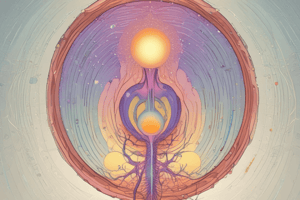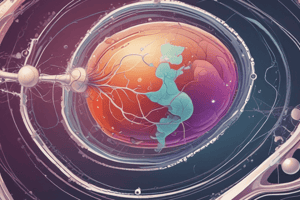Podcast
Questions and Answers
What is the immediate result of fertilization?
What is the immediate result of fertilization?
- A morula
- A zygote (correct)
- An embryo
- A blastocyst
Which part of the sperm cell contains mitochondria, which are crucial for energy production during its journey to the egg?
Which part of the sperm cell contains mitochondria, which are crucial for energy production during its journey to the egg?
- Tail
- Middle piece (correct)
- Head
- Acrosome
Why is it biologically significant that the zygote receives cytoplasm and organelles exclusively from the oocyte?
Why is it biologically significant that the zygote receives cytoplasm and organelles exclusively from the oocyte?
- To allow for the expression of both maternal and paternal genes equally.
- To ensure genetic diversity in the offspring.
- To prevent the introduction of paternal mitochondrial DNA. (correct)
- To provide the zygote with essential nutrients for early development.
Which structure is penetrated by several sperm cells before one eventually enters the egg?
Which structure is penetrated by several sperm cells before one eventually enters the egg?
What is the primary role of the digestive enzymes released by the acrosome during fertilization?
What is the primary role of the digestive enzymes released by the acrosome during fertilization?
Which of the following events directly follows the fusion of the egg and sperm plasma membranes?
Which of the following events directly follows the fusion of the egg and sperm plasma membranes?
What is the primary functional outcome of the cortical reaction during fertilization?
What is the primary functional outcome of the cortical reaction during fertilization?
How does the depolarization of the egg's plasma membrane contribute to the prevention of polyspermy?
How does the depolarization of the egg's plasma membrane contribute to the prevention of polyspermy?
What cellular process is characterized by rapid mitotic divisions of the zygote without an increase in overall size?
What cellular process is characterized by rapid mitotic divisions of the zygote without an increase in overall size?
During embryonic development, what is the significance of the growth process?
During embryonic development, what is the significance of the growth process?
Which developmental process involves the embryo undergoing extensive changes in shape and form?
Which developmental process involves the embryo undergoing extensive changes in shape and form?
In which stage of development does the inner cell mass differentiate to form the primary germ layers?
In which stage of development does the inner cell mass differentiate to form the primary germ layers?
What is the primary function of human chorionic gonadotropin (hCG) during early pregnancy?
What is the primary function of human chorionic gonadotropin (hCG) during early pregnancy?
What structures develop from the ectoderm primary germ layer?
What structures develop from the ectoderm primary germ layer?
Which of the following adult human structures is NOT derived from the mesoderm?
Which of the following adult human structures is NOT derived from the mesoderm?
Which primary germ layer gives rise to the epithelial lining of the respiratory tract and associated glands?
Which primary germ layer gives rise to the epithelial lining of the respiratory tract and associated glands?
During which weeks of embryonic development do limb buds typically appear?
During which weeks of embryonic development do limb buds typically appear?
What is the role of the chorionic villi?
What is the role of the chorionic villi?
What milestone of development occurs during the sixth through eighth weeks?
What milestone of development occurs during the sixth through eighth weeks?
During which period of development is the developing human most susceptible to environmental influences, such as chemicals and radiation?
During which period of development is the developing human most susceptible to environmental influences, such as chemicals and radiation?
What is the term for the uterine contractions that may occur near the end of pregnancy but do not lead to labor?
What is the term for the uterine contractions that may occur near the end of pregnancy but do not lead to labor?
What is the primary role of oxytocin in the positive feedback loop during labor?
What is the primary role of oxytocin in the positive feedback loop during labor?
What triggers the release of oxytocin labor?
What triggers the release of oxytocin labor?
Why is maintaining progesterone critical in early pregnancy?
Why is maintaining progesterone critical in early pregnancy?
In what circumstance is an ectopic pregnancy most likely to occur?
In what circumstance is an ectopic pregnancy most likely to occur?
Flashcards
Fertilization
Fertilization
The union of a sperm and an egg, forming a zygote.
Sperm Tail
Sperm Tail
A flagellum that propels the sperm towards the egg.
Sperm Middle Piece
Sperm Middle Piece
Contains mitochondria for energy production.
Sperm Head
Sperm Head
Signup and view all the flashcards
Sperm Nucleus
Sperm Nucleus
Signup and view all the flashcards
Corona Radiata
Corona Radiata
Signup and view all the flashcards
Acrosome Function
Acrosome Function
Signup and view all the flashcards
Polyspermy Prevention
Polyspermy Prevention
Signup and view all the flashcards
Cleavage
Cleavage
Signup and view all the flashcards
Growth (Embryonic Development)
Growth (Embryonic Development)
Signup and view all the flashcards
Morphogenesis
Morphogenesis
Signup and view all the flashcards
Pre-Embryonic Development
Pre-Embryonic Development
Signup and view all the flashcards
Embryonic Development
Embryonic Development
Signup and view all the flashcards
Ectopic Pregnancy
Ectopic Pregnancy
Signup and view all the flashcards
Human Chorionic Gonadotropin (HCG)
Human Chorionic Gonadotropin (HCG)
Signup and view all the flashcards
Gastrulation
Gastrulation
Signup and view all the flashcards
Ectoderm
Ectoderm
Signup and view all the flashcards
Mesoderm
Mesoderm
Signup and view all the flashcards
Endoderm
Endoderm
Signup and view all the flashcards
Future Umbilical Cord
Future Umbilical Cord
Signup and view all the flashcards
Umbilical Cord
Umbilical Cord
Signup and view all the flashcards
Limb Bud Development
Limb Bud Development
Signup and view all the flashcards
Sixth-Eighth Week Appearance
Sixth-Eighth Week Appearance
Signup and view all the flashcards
Fetal Development
Fetal Development
Signup and view all the flashcards
Braxton Hicks contractions
Braxton Hicks contractions
Signup and view all the flashcards
Study Notes
- Fertilization is the union of a sperm and an egg, forming a zygote, which is the first cell of a new individual.
Parts of a Sperm Cell
- Consists of a tail (flagellum) that propels the sperm toward the egg.
- The middle piece contains mitochondria.
- The head contains the nucleus capped by an acrosome, which contains digestive enzymes.
- Only the sperm's nucleus contributes to the zygote; the zygote receives cytoplasm and organelles from the mother.
Steps of Fertilization
- The egg is surrounded by the zona pellucida and layers of follicular cells called the corona radiata.
- Several sperm cells will penetrate the corona radiata, though only one will enter the egg.
- The acrosome releases digestive enzymes to forge a pathway through the zona pellucida.
- The plasma membranes of the egg and sperm fuse, and the entire sperm enters the egg.
- The nuclei of the egg and sperm then fuse together.
- Polyspermy prevention occurs when a sperm contacts the egg, the egg's plasma membrane depolarizes to prevent binding of other sperm.
- Cortical granules release enzymes that change the zona pellucida into a fertilization membrane.
- This modification prevents sperms from binding to the zona surface as well as penetrating the zona matrix, thus preventing fusion with the egg.
Processes of Development
- Cleavage occurs immediately after fertilization, with the zygote dividing by mitosis, and cells not increasing in size.
- Growth takes place during embryonic development, where cell division is accompanied by increasing cell size.
- Morphogenesis is when the embryo changes shape.
Stages of Development
- Pre-embryonic development occurs during week 1.
- Embryonic development takes place from weeks 2 to 8.
Embryonic Development: Second Week
- Implantation occurs at the end of the first week, resulting in clinical pregnancy.
- Ectopic pregnancy involves implantation outside the uterus, typically in the uterine tubes, posing health risks.
- During implantation, the chorion secretes human chorionic gonadotropin (HCG).
- HCG secretion is the basis for pregnancy tests, and it also secretes progesterone to prevent menstruation.
- Gastrulation is when the inner cell mass becomes the embryonic disk.
- Cells develop in primary germ layers which include the ectoderm, mesoderm, and endoderm.
Primary Germ Layers
- Ectoderm (outer layer) forms the epidermis of the skin, epithelial lining of the oral cavity and rectum, and the nervous system.
- Mesoderm (middle layer) gives rise to the skeleton, muscular system, dermis of the skin, cardiovascular system, urinary system, reproductive system, and outer layers of the respiratory and digestive systems.
- Endoderm (inner layer) develops into the epithelial lining of the digestive and respiratory tracts, associated glands, and the epithelial lining of the urinary bladder.
Fourth and Fifth Weeks
- The future umbilical cord connects the embryo to the chorion via chorionic villi.
- The umbilical cord forms, connecting the developing embryo to the placenta.
- Limb buds appear and develop into arms and legs.
- The head enlarges, and eyes, ears, and nose become distinguishable.
Sixth Through Eighth Weeks
- The embryo begins to appear human
- The nervous system develops to allow for reflex actions.
- By the end of this period, the embryo measures about 38 mm (1.5 in.) long.
- All organ systems have been established.
Fetal Development
- This stage spans from the third to the ninth months.
- The fetus takes on a human appearance, increasing in size and gaining weight.
- The fetus is susceptible to environmental factors like chemicals and radiation.
Birth
- The uterus contracts throughout pregnancy
- Closer to the pregnancy's end, contractions strengthen and become more frequent.
- Braxton Hicks contractions are known as false labor.
- A positive feedback mechanism occurs during labor where uterine contractions are induced by the stretching of the cervix.
- Stretching of the cervix causes the release of oxytocin from the posterior pituitary gland.
- Oxytocin stimulates the uterine muscles to contract, pushing the fetus downwards and stretching the cervix further which stimulates the release of additional oxytocin, thus repeating the cycle until birth.
Studying That Suits You
Use AI to generate personalized quizzes and flashcards to suit your learning preferences.




